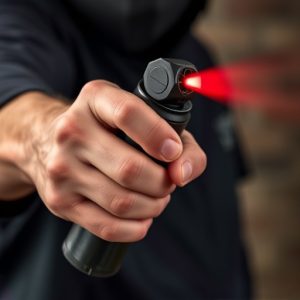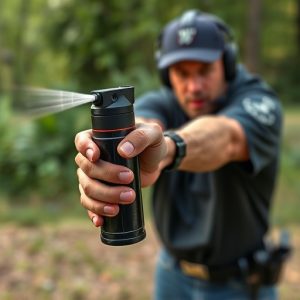Pepper Spray Safety: Storage, Legalities & Best Practices
Pepper spray, a legal self-defense tool, requires careful storage in the car. Keep it in accessible…….
Pepper spray, a legal self-defense tool, requires careful storage in the car. Keep it in accessible yet secure areas like the center console or glove compartment, away from heat and direct sunlight to maintain effectiveness. Follow local laws regarding possession and use, and always store it out of children's reach. Proper deployment involves targeting the attacker's face while minimizing collateral damage; post-use, seek medical attention, dispose of the canister properly, and document the incident. Regular practice and understanding its mechanics ensure effective self-defense.
“Uncover the power of pepper spray as a personal defense tool, and learn how to harness it effectively. This comprehensive guide explores its role in safeguarding your safety, offering insights into understanding its mechanics, and navigating legal boundaries. Discover best practices for storage—crucial when keeping it in your car—ensuring its readiness when needed. From learning the right use protocols to practical tips for carrying, this article equips you with knowledge to make informed decisions about pepper spray self-defense.”
- Understanding Pepper Spray as a Self-Defense Tool
- Safeguarding Your Pepper Spray: Storage Guidelines
- Legal Considerations and Use Protocols
- Best Practices for Carrying and Using Pepper Spray
Understanding Pepper Spray as a Self-Defense Tool
Pepper spray is a powerful self-defense tool that can provide individuals with a non-lethal means to protect themselves against potential threats. It works by temporarily disabling an attacker, causing irritation and pain in the eyes, nose, and throat, allowing the user to escape or seek help. Understanding how pepper spray functions and its limitations is essential for responsible use.
Proper storage of pepper spray, such as keeping it in the car, is crucial for safety. It should be placed in an easily accessible yet secure location, out of reach of children and unauthorized individuals. Many pepper spray models designed for vehicles come with special clips or mounts that attach to the dashboard or sun visor, ensuring they are within grasp during an emergency but not easily visible to deter potential thieves.
Safeguarding Your Pepper Spray: Storage Guidelines
Storing pepper spray safely is just as crucial as knowing how to use it effectively for self-defense. When keeping pepper spray in your car, place it in an easily accessible location, but not within immediate reach. The center console or glove compartment are ideal storage spots, ensuring they remain closed and secure during transit. Avoid storing it near heat sources, like the dashboard, as extreme temperatures can compromise its potency and shelf life.
For added protection, consider using a specialized carrier designed for pepper spray storage in cars. These carriers often come with lockable features, further deterring unauthorized access. Remember, proper storage doesn’t render the spray useless; it ensures its readiness when needed most while minimizing risks associated with accidental discharge or spoilage.
Legal Considerations and Use Protocols
In many jurisdictions, pepper spray is considered a legal self-defense tool when used appropriately. However, understanding local laws and regulations regarding its possession and use is crucial before carrying it for personal safety. Owning and storing pepper spray in your car may be subject to specific guidelines, such as registration or permit requirements, varying by region. It’s essential to check with your local law enforcement agency for accurate information on legal limits, permitted storage locations (e.g., glove compartment or trunk), and circumstances under which its use is justified.
When it comes to deployment protocols, using pepper spray requires caution and responsibility. Act only as a last resort when facing an imminent threat. Targeting the attacker’s face ensures maximum effectiveness while minimizing collateral damage. After use, immediately seek medical attention if needed, dispose of the canister properly, and consider documenting the incident for future reference. Safe storage practices include keeping the spray out of reach of children and other unauthorized individuals, ensuring it remains sealed, and locating it in a readily accessible yet secure area within your vehicle.
Best Practices for Carrying and Using Pepper Spray
When carrying pepper spray for self-defense, proper storage is paramount. It’s recommended to keep it in an easily accessible yet secure location within your vehicle. The dashboard or center console are often ideal choices as they provide quick reach during an emergency while also protecting the spray from extreme temperatures and direct sunlight, which can affect its potency. Ensure the container is sealed tightly and consider storing it alongside essential emergency items like a first aid kit.
Using pepper spray effectively requires understanding its mechanics. Always aim for the face, eyes, and nose, as these areas are most sensitive to the irritant. Practice your technique regularly, especially in low-light conditions or while wearing protective gear, mirroring real-life scenarios. Keep your trigger finger off the trigger until you intend to deploy it, ensuring accidental discharges are avoided. After use, promptly clean and store your spray to maintain its functionality for future situations.
Pepper spray can be an effective self-defense tool when used responsibly. To ensure its safety, proper storage is crucial, especially when keeping it in your car (Pepper Spray Storage in Car). Always follow legal guidelines and use protocols, understanding the potential consequences of misuse. By adhering to best practices for carrying and using pepper spray, you can maximize its effectiveness while minimizing risks, empowering you to protect yourself confidently.


